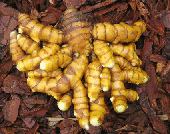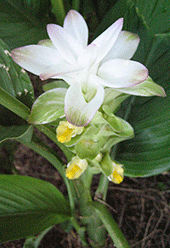| Organic Seeds | Edible Plants | Organic Pest Controls | Books | Tools, Propagation & Fertilisers | Sprouting & Microgreens | Poultry Supplies | Specials & Gift Ideas |

Top

We will send an email to this address*
when is next available
* we will use this email address only for this notification and then we will delete it.
 Home
Home
Green Harvest Organic Gardening Supplies is permanently closed as of 5pm on 1-11-2023.
We will not be taking orders by this website, in person, by phone or email. Our display garden and retail shop are closed forever.
Read more...
Phone:07 54357000
Phone calls will only be responded to sporadically and only in reference to orders placed prior to 2-11-2023. All the useful growing and organic pest management research and resources are available on this website for a while still.
 AVAILABLE FOR PURCHASE:
buy or get emailed when available
AVAILABLE FOR PURCHASE:
buy or get emailed when availableTURMERIC GROWING INFORMATION © Frances Michaels
BOTANICAL NAME: Curcuma domestica syn. Curcuma longa
COMMON NAMES: turmeric; Indian saffron; ukon; nghe; wong-keong
FAMILY: Zingiberaceae, the ginger family
PLANT DESCRIPTION
Turmeric is native to the monsoon forests of south east Asia. It is a perennial herb to 1m tall with underground rhizomes. It produces tall, very beautiful, white flower spikes, if clumps are left undisturbed for a year. The flower is so attractive that it is worth growing for this alone. It requires a well-drained soil, frost-free climate and 1000 to 2000mm of rain annually or supplementary irrigation. It thrives best on loamy or alluvial fertile soils and cannot stand waterlogging. Heavy shade will reduce the yield but light shade is beneficial.
 USES
USESGround turmeric comprises 25% of curry powder and is used to give it a yellow colour. The harvested rhizomes are boiled and sun-dried for 7-8 days but can be used fresh. It is also used as a yellow food dye, replacing tetrazine. Leaves wrapped around fish flavour it during cooking. In Indonesia, the young shoots and rhizome tips are eaten raw.
PLANTING DETAILS
Plant turmeric in September or October, into a warm soil. The rhizomes should be planted 5-7 cm deep. It is often planted on ridges, usually about 30-45 cm apart and with 15-30 cm between plants. The crop is planted by setts (small rhizomes) with one or two buds. Approximately 1,700 kg of setts are required to one hectare. Expected yield would be 13 to 35 tonnes/ha of fresh turmeric. In cooler areas of Australia turmeric can be grown in glasshouses. Like all herbaceous perennials clumps of turmeric need to be broken up and fresh pieces planted every 3 to 4 years.
HARVEST
Rhizomes are harvested 9 to 10 months after planting, the lower leaves turning yellow or stems drying and falling over are indications of maturity. It is possible for the home gardener to just dig carefully at the side of a clump and remove rhizomes as needed rather than harvesting the whole clump.
Recent research from a study in the Journal of the American Chemical Society into turmeric, commonly used as a spice and curry ingredient, has demonstrated wide-ranging health giving properties.
RECIPES
Superfood Latte
An anti-inflammatory Ayurvedic healing cuppa.
- ½ teaspoon of turmeric (fresh grated or powder)
- ½ teaspoon of fresh grated ginger
- 2-3 peppercorns
- 2 cups of milk
- Spices (optional) cardamom, nutmeg, cinnamon, cayenne pepper
- Honey to taste
Golden Milk or haldi ka doodh is used in Indian natural medicine as a winter drink to heal coughs and sore throats. Trendy cafes worldwide are now offering an espresso or golden latte with a similar recipe.
Anti-inflammatory Shots
'Shots' of juice full of vitamin C, antioxidants, and proven antiviral qualities. This quick drink can help soothe sore throats, cure upset stomachs and will become your favourite daily tonic.
Ginger and turmeric are spices known for their anti-inflammatory and cancer-preventing properties and when combined with orange juice is super easy to prepare.
- 1/2 cup of freshly squeezed orange juice
- 12 mm piece of fresh ginger, grated
- 12 mm piece of fresh turmeric, grated
- 2 tablespoons of honey
Not to NORFOLK ISLAND, NT, SA, TAS or WA
SORRY but due to quarantine restrictions between Australian States no plants at all can be ordered by residents of Norfolk Island, Tasmania and Western Australia. These restrictions are very important as they prevent the spread of plant pests and diseases. No potatoes, garlic, shallots, strawberries or tubestock can be sent to South Australia. No tubestock can be sent to Northern Territory.
 Home
Home
Green Harvest Organic Gardening Supplies is permanently closed as of 5pm on 1-11-2023.
We will not be taking orders by this website, in person, by phone or email. Our display garden and retail shop are closed forever.
Read more...
Phone:07 54357000
Phone calls will only be responded to sporadically and only in reference to orders placed prior to 2-11-2023. All the useful growing and organic pest management research and resources are available on this website for a while still.
DISCLAIMER:
No liability will be accepted by Green Harvest, its owners or employees as to the accuracy of any information. No responsibility will be taken for damage to property or persons due to information given about a product or technique. No responsibility will be taken for the loss of a crop or income due to information given about a product or technique.
 Shopping here is private and secure.
Shopping here is private and secure.
Copyright © 2001 - 2024 Green Harvest Organic Gardening Supplies
No part of this website may be reproduced without permission of the owner
SORRY but due to quarantine restrictions between Australian States no plants at all can be ordered by residents of Norfolk Island, Tasmania and Western Australia. These restrictions are very important as they prevent the spread of plant pests and diseases. No potatoes, garlic, shallots, strawberries or tubestock can be sent to South Australia. No tubestock can be sent to Northern Territory.
 Home
Home
Green Harvest Organic Gardening Supplies is permanently closed as of 5pm on 1-11-2023.
We will not be taking orders by this website, in person, by phone or email. Our display garden and retail shop are closed forever.
Read more...
Phone:07 54357000
Phone calls will only be responded to sporadically and only in reference to orders placed prior to 2-11-2023. All the useful growing and organic pest management research and resources are available on this website for a while still.
No liability will be accepted by Green Harvest, its owners or employees as to the accuracy of any information. No responsibility will be taken for damage to property or persons due to information given about a product or technique. No responsibility will be taken for the loss of a crop or income due to information given about a product or technique.
 Shopping here is private and secure.
Shopping here is private and secure.
Copyright © 2001 - 2024 Green Harvest Organic Gardening Supplies
No part of this website may be reproduced without permission of the owner